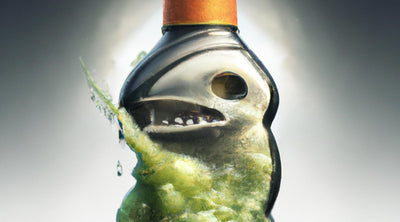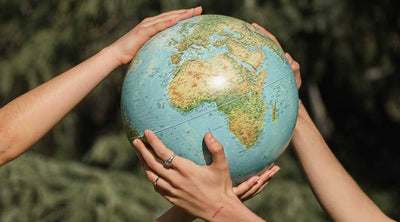The Footprint of Food
May 25, 2020If we wish to have the biggest possible impact on the planet from our actions, most of that will come from the seemingly small, yet consistent actions that we take every day.
This is why switching to things like a reusable q-tip, a reusable cotton round, or other zero waste switches are so impactful. Not only do they add up because we do them so consistently, but they also affect our way of thinking which overflows into other aspects of our lives.
What other actions do we take rather consistently? Oh! How about eating?!
As we’ve learned from our previous article on how to reduce our carbon footprint, food is a large part of that. We all eat (hopefully) every day and often several times! What an incredible advantage to have so many opportunities to cast our vote and have an impact.
The footprint of food
For a better visual of the above graph, click here.
All food requires resources like energy, water, land, and nutrients. The more we work our way up the food chain, the more resources we will be consuming.
Plants, for example, will require things like sunlight, water, and nutrients to grow. As well as energy, land, and emissions for us to harvest and transport them. Whereas cattle require land, energy, transportation, and food. That food usually comes from plants, which requires its own resources.
Resources, therefore, begin to stack up.
If we were to hunt a predator species like a wolf for example, that would demand even more resources! It would require the resources of what it hunts, which requires the resources to live as well as the food it eats.
Simply in terms of energy and resources, it is far more efficient for us to eat plants.
Water
For a water footprint, animal products are clearly more thirsty than plants. One pound of beef is said to be responsible for 1,800 gallons of water. And sure, while pigs and chickens require less water than beef, they still require far more than plants do.
How did we arrive at this number? Well, the numbers are sort of all over the place. But not only is this number in the middle, it also has the most consensus and rigorous research. More on that here.
Again, going back to the idea of energy: this footprint is so high because animals eat plants (which require water) on top of the water they drink, which is also quite a bit.
Land Use
Land use is also a large factor that goes into the carbon footprint of food. Unless a plant is grown in an aquaponic style, or meat in a lab (both of those being very exciting), soil and land is required.
Forests and wilderness is vital to a healthy planet, and the more animals we need to raise, the more trees and wildlife we will need to destroy.
And while animals naturally need far more land than plants to live (especially ethically), neither plants nor animals are very sustainable when grown and raised in the way they are now.
Because even plants, when farmed in a non-regenerative and large scale way, degrade the soil over time and will lead to us searching for more land. AKA less habitat and trees.
Emissions
Especially when it comes to animal products, there will be emissions associated with raising these animals like cows. Cows, along with their manure, produce a pretty massive amount of Methane.
And while CO2 gets the bad rap because of how much is put into the atmosphere, Methane is also a major issue, due to how much more potent it is.
While emissions usually come from cows and farming equipment in animal agriculture, flooded rice crops also produce methane, which is responsible for the majority of rice’s footprint. Otherwise, rice is a pretty low resource crop.
Transport
Additionally, everything, no matter the resources needed to grow it, will need to be shipped and transported. This then adds to the emissions and carbon footprint of food.
Pesticides and fertilizers
Going back to the large scale and non regenerative way of growing food, most of the time farms require the need for pesticides and fertilizers.
Silent Spring, a book by Rachel Carson, is a great book that talks a lot about pesticides and is responsible for the banning of DDT in the USA.
Pesticides can leach into waterways, harm essential insects like pollinators, affect our health, and can lead to pesticide resistant weeds which require even stronger and more amounts of pesticides.
Fertilizers, whether they be manure, nitrogen based, or phosphorus based, can harm the planet along with the animals and humans on it. Most of the impact comes from getting into waterways thus affecting plant and aquatic life.
This can cause things like algal blooms. The added nutrients rapidly grows algae and when that algae dies it starves the water of oxygen, killing off all the organisms and animals that require it.
Synthetic fertilizers and pesticides are commonly found in most fish these days, as well as nearby land animals, and therefore reaching humans as well.
So, what do we do with this information?
Whenever these articles become more educational and footprint based, they tend to feel a little more dark and gloomy as well. But don’t fear, because as we learn about the footprints of food and their impact, we can also begin to learn what has a bigger footprint and what has a smaller one.
Since we know this, we already know ways to eat a more planet friendly diet. However, there are things that may be a bit more complex to decipher like organic vs local, how to get the right nutrition, etc.
In the next article, we will go more into depth on how to eat a more planet friendly diet. We’ll be talking about what foods to choose for a lower footprint as well as how to get the right nutrition from them. We will also dig into the finer details associated with a planet friendly diet.
Sit with this information, take it in, and get ready to turn it into action!
MORE Sustainability 101 ARTICLES View all ›
Ready to make
the switch?
- Powerful Cleaning
- Dissolves Easily
- Skin-Friendly
- Eco-Friendly
- No Mess


















